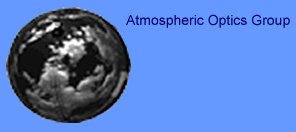
 |
| |
|
|
|
|
|
|
|
Improved Solar/Lunar OccultorA new solar/lunar occultor design has recently been completed, as shown in the figure below. The occultors have gone through a series of developments over the years. In order to calibrate the images radiometrically, we must not only prevent blooming by masking the sun in the image, but we must minimize stray light by shading the full front surface of the lens and dome. Since the Day/Night WSI lens is fairly large, this implies the need for a fairly large shade. In order that the shade not obscure an unreasonable portion of the field of view, it must also be held at a significant distance from the dome. In addition, in order to shade either the sun or the moon, the simple equatorial occultor used in the Day WSI models is not sufficient; we need a version with two degrees of freedom of motion. This combination of requirements presents engineering challenges. The first solar/lunar occultors were built in the early 90’s, when the first D/N WSI units were deployed. They used a cantilevered flag rotating around the lens. They worked reasonably reliably, but were vulnerable due to the forces at the point of rotation of the arm. The next generation built in the mid 90’s was more robust, with an arc which traveled from East to West, and a trolley which traveled from North to South. These versions worked reasonably well, however the trolley was prone to slippage if the rotating parts were not kept clean and serviced. We further improved the design on newer systems built in the late 90’s to early 00’s. These new designs included reduced friction, as well as slip clutches integrated into the trolley design. These occultors have proved to be very robust and reliable. The most recent model of the occultor is shown below. It is designed to considerably reduce the uncertainties in the final position of the occultor, so that it can be more accurately masked from the images. The desire to mask the minimum area of the image resulted in a requirement for smaller tolerance in the position readout accuracy. A number of tests went into determining the sources of the uncertainties in the readout position. Much of the uncertainty was due to non-linearities in the electronics, which have now been mitigated by substituting encoders in the readout. There was also significant mechanical flexing, as shown in the figure below, which shows the results of a test of mechanical deflection as a function of load for various designs. The design with the minimal deflection was chosen.
Other improvements were made, including use of gearheads with less backlash. In addition, the occultor was designed to minimize the solid angle obscuration, as shown in the figures below comparing the old and new occultor. The new occultor can also go below the horizon to be out of the field of view for cases with no moon or sun.
Produced
by the Marine Physical Laboratory, SIO.
|